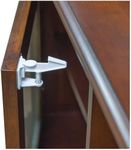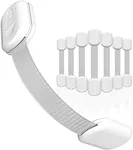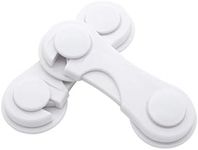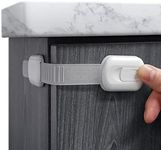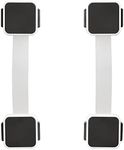Buying Guide for the Best Baby Cabinet Locks
Choosing the right baby cabinet locks is an important step in childproofing your home and keeping your little one safe. The main goal is to prevent curious babies and toddlers from accessing cabinets that may contain dangerous items like cleaning supplies, medicines, or sharp objects. When shopping for cabinet locks, it's important to consider how easy they are for adults to use, how secure they are against little hands, and whether they fit your specific cabinets. Understanding the key features will help you pick the best option for your family's needs.Locking MechanismThe locking mechanism refers to how the lock actually secures the cabinet doors or drawers. Common types include magnetic locks, adhesive strap locks, sliding locks, and spring-action locks. Magnetic locks are hidden inside the cabinet and require a magnetic key to open, making them very secure but sometimes less convenient. Adhesive strap locks stick to the outside and are easy to install, but may be more visible. Sliding locks fit around cabinet handles and are simple to use, while spring-action locks are installed inside and require you to press a latch to open. If you want something discreet and very secure, magnetic or spring-action locks are a good choice. For quick installation and flexibility, adhesive or sliding locks might be better. Consider your cabinet style and how often you need to access the contents when choosing.
Installation MethodInstallation method describes how the lock attaches to your cabinet. Some locks require screws and drilling, which makes them very sturdy but can leave permanent marks. Others use strong adhesive tape, which is easier to install and remove but may not be as durable over time. If you are renting or want to avoid damaging your cabinets, adhesive options are preferable. If you need a long-term, very secure solution, screw-in locks are worth considering. Think about whether you want a temporary or permanent fix and how much effort you want to put into installation.
Ease of Adult UseEase of adult use means how simple it is for grown-ups to open the lock while still keeping it secure from children. Some locks require two hands or a special key, which can be inconvenient if you need to access the cabinet frequently. Others can be opened with one hand or a simple press, making them more user-friendly. If you use the cabinet often, look for locks that balance security with convenience for adults. If the cabinet is rarely used, a more complex lock may be fine.
Compatibility with Cabinet TypesCompatibility refers to whether the lock will fit your specific cabinet or drawer style. Some locks are designed for double-door cabinets, while others work best on single doors or drawers. The thickness of your cabinet doors, the shape of the handles, and the material of the cabinet can all affect which locks will work. Before buying, check the product details to make sure the lock is suitable for your cabinet type. If you have unusual or thick cabinet doors, look for adjustable or universal locks.
Durability and MaterialDurability and material refer to how well the lock will hold up over time and what it is made from. Locks made from high-quality plastic or metal are generally more durable and can withstand repeated use and pulling by children. Cheaper materials may break or wear out quickly. If you expect to use the locks for several years or have a very active child, choose locks made from sturdy materials. If you only need them for a short period, less expensive options may be sufficient.
Visibility and AestheticsVisibility and aesthetics describe how noticeable the lock is and how it looks on your cabinets. Some locks are designed to be hidden inside the cabinet, while others are visible on the outside. If you prefer a clean look and don't want the locks to stand out, choose hidden or low-profile options. If appearance is less important, visible locks may be easier to install and use. Consider your home decor and personal preference when deciding.





